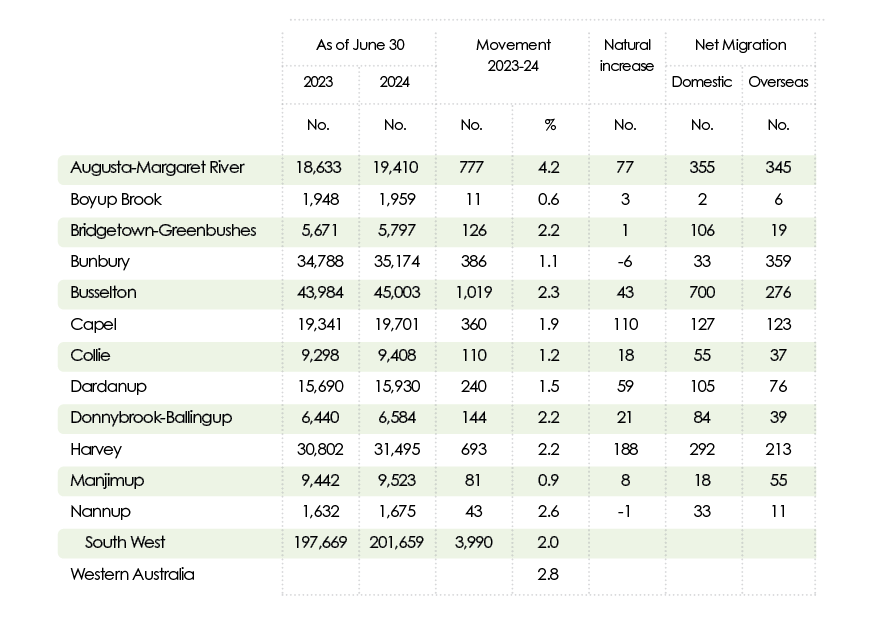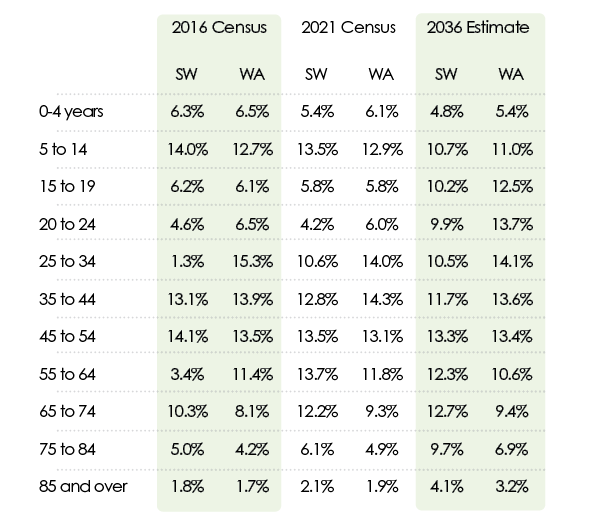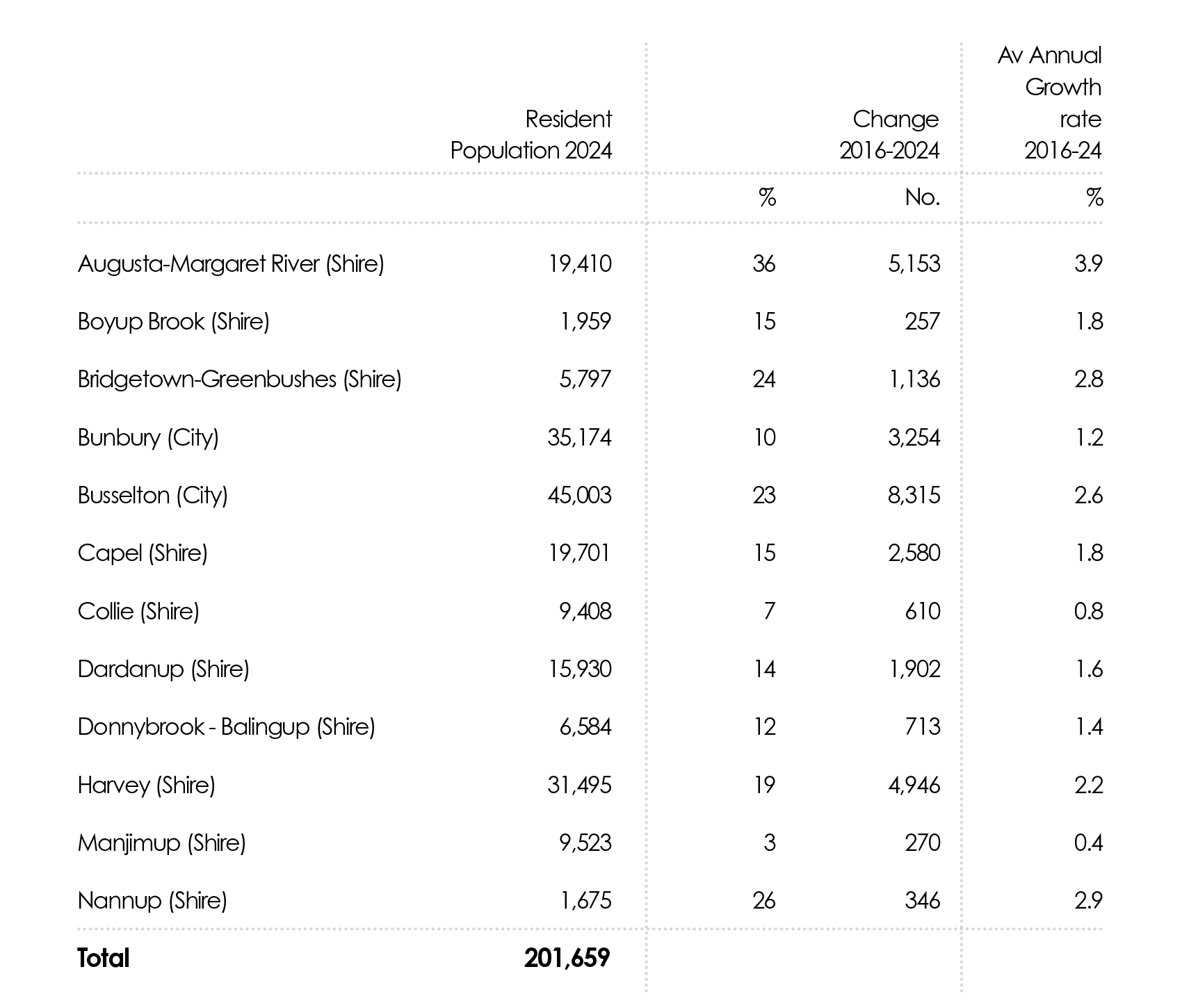Population forecasting by WA Tomorrow was revised down as a result of very low migration numbers, a Covid impact that will resonate for some years. For the South West the impact is a greater number of aged persons, less aged to 14 years, and the dependency ratio will rise to 38% by 2063 (Intergenerational Report), a trend consistent with other developed nations. The regional population (201,659 in 2024) has grown steadily and at a faster rate than most of regional WA. The coastal strip remains popular with the Bunbury-Busselton axis being home to more than half of the whole region’s population and accounting for about 55% of the region’s workforce. The urban footprint that makes up Greater Bunbury accounts for almost 80,000 people.
All Local Government areas have grown since 2015 but experience different drivers: net overseas migration; net internal migration; and/or natural increase. The fastest growing local government is the Shire of Augusta-Margaret River followed by the Shires of Bridgetown and Boyup Brook. All areas have gained through net internal migration.
The City of Bunbury is constrained by its boundary and is impacted by the social trend to have less persons per household. The Regional Australia Institute predicts that Greater Bunbury will grow to 172,700 by 2056 and Busselton will grow to 68,500.
Inland communities, from Collie through to Manjimup, are generally more constant and reflect the nature of communities based on primary industry. These communities also feature a higher median age group.




The South West connects the traditional boundaries of Wadandi, Pibulmen, Kanenag, Pindjarup and Minang dialect groups represented by Wagyl Kaip (Boyup Brook, Bridgetown, Walpole) to the East, Gnaala Karla Booja (Bunbury, Capel, Donnybrook, Balingup, Harvey, Collie and Mandurah) to the north, and Karri Karrak (South West Boojarah: Busselton, Dunsborough, Margaret River, Pemberton and Nannup) Native Title groups. It is important to note that the region’s Noongar people have an exceptionally deep and enduring connection to booja (country) both physically and spiritually.
ILUAs are pushing forward and creating unprecedented opportunities for the region’s Aboriginal people, with huge efforts being made to boost economic engagement through Ranger programs, commercial procurement, education/training and government projects. Other significant opportunities are in culture, knowledge and art.


The United Nations Office on Drugs and Crime promotes sports and related activities to prevent crime and to effectively build resilience of at-risk youth. Strengthening the life skills of youth is a key objective of the UN’s 2030 Agenda for Sustainable Development which encourages social inclusion and links across race, gender and age.
While socially important, sports and recreational industries are generally under-rated as economic drivers for smaller industry sectors, community cohesion and tourism. They contribute to economic diversity and generate opportunity.
Sport West (2023) found the social return on investment in organised sport delivers an estimated gross benefit of $10.3bn per year In Western Australia. For every dollar of economic and social investment into sport, more than $7 of economic and social benefit are fostered.
As greater value is put on personal time and interests, discretionary spending boosts sectors from recreational fishing to racing and pacing. The South West racing and pacing industry supports thoroughbred racing in Bunbury and Collie, and trotting clubs in Bridgetown, Bunbury, Busselton and Collie. Bunbury Turf Club is the region’s premier facility. Bunbury enjoyed an almost $30m upgrade which has enabled year-round training and racing in what is the leading regional facility in Western Australia. The redevelopment also saw the creation of 150 state-of-the-art horse stalls with remodelled access, and some new buildings.
As a result of the redevelopment, it is estimated that the uplift in total direct expenditure generated by training activities at Bunbury racecourse will amount to $30.8mpa by 2028-29.
Offering unsung value to the recreational sector are community sports facilities as regional and intra-regional attractors for events that drive visitation. So too are motorsport facilities such as Manjimup Cosy Creek, Bunbury Speedway and Collie Motorplex, the latter features a 2.6km track, the longest in WA. Given its out-of-town location and proximity to overnight accommodation, Collie Motorplex has genuine potential to rival the State’s premier circuit over the long term.
Upgrades to Hands Oval has seen professional AFL brought to Bunbury. The West Coast Eagles played twice in 2025 while Fremantle will play in 2026. The Australian Women’s National Soccer Team, the Matildas will play Panama in Bunbury in 2025.
While traditional structured sport remains popular, outdoor recreational activities have seen growth. Activities make a huge contribution to the health and wellbeing of individuals and communities in the South West. Every day, the region’s unique outdoor lifestyle is enjoyed — whether walking, riding, exploring, exercising, paddling or engaging in a range of outdoor adventures activities.
The South West has a growing network of tracks and trails from the walk and cycle iconic tracks and trails (Bibbulmun 1,000km, Munda Biddi 1,072km and Cape to Cape 125km) to bridle trails, kayaking and various other speciality routes from the arts to food and wine. In addition, the WA Government has committed to the completion of the Wadandi Track to form a continuous 109km route from Busselton Jetty to Flinders Bay in Augusta.
Socio-Economic Indexes for Areas (SEIFA), Australia 2021
South West - 991
Augusta-Margaret River - 1031
Boyup Brook - 995
Bridgetown-Greenbushes - 1,000
Bunbury - 944
Busselton - 1,019
Capel - 1,016
Collie - 908
Dardanup - 1,006
Donnybrook-Balingup - 987
Harvey - 998
Manjimup - 959
Nannup - 978
However, the region scores below the average based on the Socio-Economic Indexes For Areas (SEIFA) which measures relative disadvantage – employment, income levels, educational achievement and internet access. SEIFA scores have flaws but do provide a general picture, noting where interventions would be useful.
Weekly household incomes are most commonly in the $2,000-$3,499 range, with more than a quarter of all households falling in these statistical brackets. The figures may trend slightly higher since Census data relates to the area where the person was resident at the time ie. the region’s FIFO workforce would be recorded in other area data.
The economic contribution of the arts is well recognised in the South West. The region features Australia’s largest film prize through CinéfestOZ, Western Australia’s premier country music event at Boyup Brook and a multitude of food-related events which contribute to the regional brand through promoting excellence in agricultural production.
Events drivers include Southern Forests produce, regional wines and Cabin Fever Festival among many others that include premium drinks and food as key components of mixed packages. The Capes region features Margaret River Open Studios which attracts thousands of visitors each year to experience art in many forms. There are also regional music events from the Bridgetown Blues and Boyup Brook Country Music Festival, to Busselton’s Jazz by the Bay and capacity for travelling shows at the region’s entertainment centres.
The region has a wealth of other cultural connections – field days, cars and medieval carnivale – that add to the richness of the community as well as the economy in providing impactful visitation triggers.
The South West Natural Resource Management region incorporates 26 LGAs and is at the heart of the South West Botanical Province, one of only 36 biodiversity hotspots in the world, highlighting its rich diversity of flora and fauna. The NRM region also features four wetland systems of international significance recognised under the Ramsar Convention. The coastal environment is one of the South West’s greatest assets in cultural, community, economic and environmental value. The Southern Forests are also of great value, noting that two-thirds of the entire region is made up of State forest, National Parks and regional parks.
The region enjoys a Mediterranean climate with hot dry summers and wet winters. The region is facing climate pressures, particularly declining rainfall and sea level rises. CSIRO’s most comprehensive assessment of water yield found that the South West was one of the most water-challenged regions in Australia, noting a 15% decline in rainfall since 1975. With modelling suggesting a declining surface water yields of 24% in the next decade (CSIRO) then water issues must be considered a regional priority.
Further, the Bureau of Meteorology reports that WA temperatures have increase by 1.52˚C (BoM 2024) since records began in 1910 and the Climate Commission found that local sea level rises have been the highest in Australia at 7.4mm/pa since the early 1990s, a combination of isostatic and eustatic influences. In 2010 the WA Planning Commission specified that SLR should be taken as +0.9m by 2100 while a Department of Transport’s state-wide assessment highlights the South West as extremely vulnerable: Bunbury and Busselton were recently listed among the top three WA locations at “extreme” susceptibility to coastal inundation. The latest data ranges exceed 1m and does not account for storm surge.
The South West is Australia’s canary in the cage, pointing to opportunities for academic research and pilot interventions in climate adaptation strategies in everything from home design and energy to bushfire and extreme weather events.
It is an increasing challenge to manage risks posed to the South West which is under pressure given that its landscapes are a drawcard that in turn requires management to save it from those who seek to experience its natural beauty.